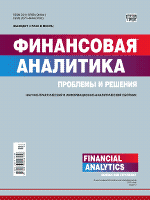Abstracting and IndexingРИНЦReferativny Zhurnal VINITI RAS Worldcat Google Scholar Online availableEastvieweLIBRARY.RU Biblioclub |
Research and development expenditures, stock returns and sales growth of biopharmaceutical firms
Available online: 30 August 2014 Subject Heading: Investment policy JEL Classification: Pages: 39-52
The study examines the relationship between research and development expenditures, stock prices and sales growth of biopharmaceutical firms. According to the accounting principles generally accepted in the USA, intangible assets are out the balance sheets and firms report research and development expenditures as expenses. In order to demonstrate that this kind of expenditures can be adopted as intangible assets, the standard analysis methods (portfolio and cross-section) and calculations (price- and equally-weighted) have been used. A sample includes 72 biopharmaceutical firms traded in the USA with available accounting data over the period from 2002 to 2012. The firms are sorted on the basis of research and development spending intensity. Both high and low intensive firms have been considered as potential investment targets. Equally-weighted calculations of stock returns and sales growth of biopharmaceutical firms with high intensity of research and development spending find some reasons for buying their stocks while price-weighted ones contradict this suggestion mostly. In addition, the following findings have been made: the research and development intensity level can be used as a selection criterion; the selection criterion based on this intensity level generally underperform traditional selection criteria; sales growth is not always incorporated into stock prices; the ratios research and development to the market and enterprise values are more appropriate for measuring of intensity compared to research and development to sales ratio. Keywords: research and development expenditures, stock return, sales growth, intangible assets, equity valuation, portfolio selection References:
|
ISSN 2311-8768 (Online)
|
|








